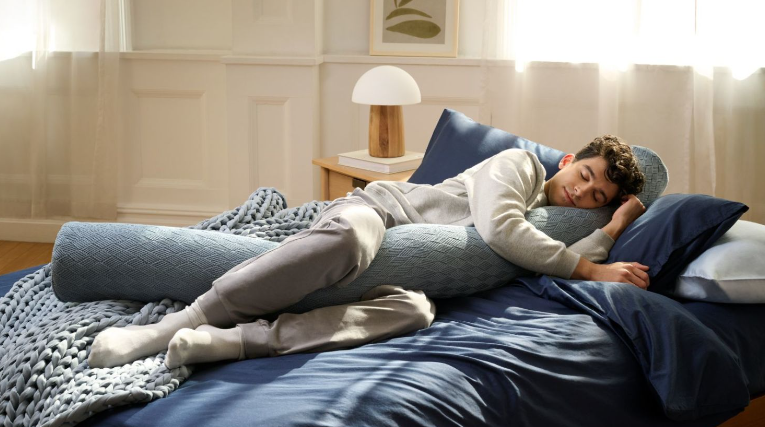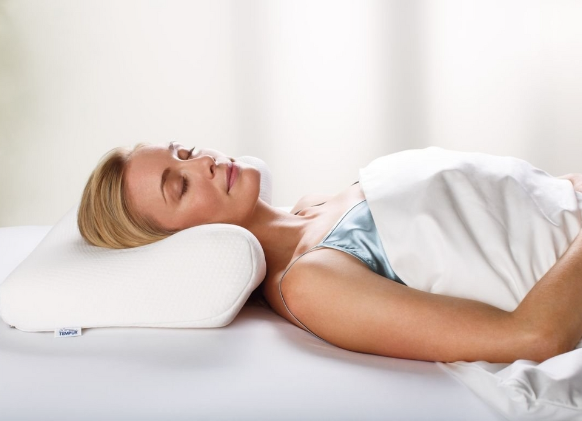Getting the most comfortable and restful night’s sleep requires more than just a quality mattress. The right pillow can make a significant difference in your sleep quality, comfort, and overall health. There are numerous pillows on the market, each designed to cater to specific sleep preferences and needs. The ‘Coop Home Goods Premium Adjustable Loft Pillow’ is one of the top-rated pillows, filled with shredded memory foam and microfiber for adjustable firmness. It’s hypoallergenic and dust mite resistant, providing a safe and clean sleeping environment.
Another excellent option is the ‘Tempur-Pedic TEMPUR-Cloud Breeze Dual Cooling Pillow’, designed with a cooling gel layer on both sides, perfect for people who tend to overheat at night. It also provides a firm yet comfortable support for your neck and head. For those who sleep on their side, the ‘Epabo Contour Memory Foam Pillow’ is recommended. Its ergonomic design aligns your neck, head, and shoulders correctly, reducing strain and discomfort. Lastly, the ‘Beckham Hotel Collection Gel Pillow’ is a luxurious choice that offers a plush yet supportive feel. It’s resistant to mold, mildew, and dust mites, ensuring a healthier sleeping surface. These pillows have been recognized for their superior comfort, support, and quality, helping you achieve a better night’s sleep.

Why Choosing the Right Pillow Matters
Choosing the appropriate pillow is a critical factor in achieving high-quality sleep and maintaining overall wellness. The selection should not be based on aesthetics alone, but on its ability to provide optimal support for the neck and spine, thereby ensuring proper alignment during sleep. An unsuitable pillow can lead to discomfort, causing various health issues such as headaches, neck pain, shoulder tension, and even snoring. Furthermore, your sleeping position – whether you are a back, side, or stomach sleeper – largely influences the type of pillow that will best suit your needs.
For instance, side sleepers require a firm, high-loft pillow to fill the distance between the ear and outside shoulder, while back sleepers need a thin, low-loft pillow to maintain the natural curvature of the spine. Stomach sleepers, on the other hand, may be comfortable without a pillow or just a very thin one. The material of the pillow is also important; memory foam, latex, down, or synthetic fillings each have unique qualities that cater to different comfort preferences. Lastly, individuals with specific health conditions like allergies or asthma should consider hypoallergenic pillows to avoid triggering symptoms. Therefore, investing in a pillow that complements your unique needs and sleep habits is crucial for creating an ideal sleep environment that promotes restful slumber and fosters overall wellbeing.
Types of Pillows for Optimal Comfort
Pillows come in a multitude of types, each designed to offer optimal comfort based on individual preferences and needs. The most common among these are bed pillows, primarily used for sleeping. They are typically filled with materials like memory foam, down feathers, polyester, or latex. Memory foam pillows adapt to the shape of your head and neck, providing excellent support and reducing pressure points. Feather pillows, on the other hand, are soft and plush, offering a luxurious feel. Polyester pillows are affordable and hypoallergenic, while latex offers a balance of support and comfort.
Body pillows are another category, designed to support the entire body and are especially beneficial for pregnant women or side sleepers. They provide additional support to the back and legs, aiding in the relief of joint and muscle pain. Travel pillows are compact and convenient, designed to offer neck support while on the go, particularly during long-haul flights or car trips.
Orthopedic pillows are specifically designed to correct body positioning in bed. They help to alleviate discomfort associated with various conditions like sleep apnea, snoring, insomnia, and acid reflux. Cervical pillows help to maintain the natural curve of the neck and provide relief from neck pain and stiffness. Wedge pillows, shaped like a ramp or triangle, are used to elevate the body and are particularly beneficial for those with respiratory issues or acid reflux.
For those who prefer cooler sleeping surfaces, cooling pillows filled with gel-infused memory foam or other cooling materials are ideal. They help to regulate body temperature and prevent overheating. Lumbar pillows, on the other hand, are used to support the lower back, particularly when sitting for extended periods.
In summary, there is a diverse range of pillows available, each offering different levels of comfort based on individual needs and preferences. Choosing the right one can significantly enhance sleep quality and overall well-being.

How to Select a Pillow Based on Sleeping Position
Selecting a pillow to match your sleeping position is pivotal for a restful night and can significantly impact your overall health. If you primarily sleep on your side, opt for a firm, thicker pillow to fill the gap between your neck and shoulder, providing adequate support to the neck and spine. Those who sleep on their back should consider a medium-thick pillow that supports the natural curvature of the spine, avoiding any unnecessary strain.
Stomach sleepers, on the other hand, would benefit from a soft, thin pillow, or potentially no pillow at all, to avoid an uncomfortable upward tilt of the head. It’s also prudent to consider the material of the pillow. Memory foam pillows can adapt to the contours of your head and neck, providing personalized support, while latex pillows are resistant to dust mites and mold, making them an excellent choice for allergy sufferers. Feather pillows can be moulded for comfort but may not provide consistent support throughout the night. On the other hand, polyester pillows are inexpensive and machine washable, but they can become lumpy over time. Therefore, it’s essential to consider your personal comfort, any potential allergies, and your preferred sleeping position when selecting a pillow to ensure a peaceful sleep cycle.
Top Brands and Their Unique Features
Top brands often distinguish themselves from their competitors by incorporating unique features into their products or services. For instance, Apple, a globally recognized technology brand, is known for its innovative and user-friendly designs. Their products, such as the iPhone or MacBook, offer an integrated and seamless experience with their software and hardware working in harmony. On the other hand, Nike, a leading sportswear brand, differentiates itself through its high-quality and performance-enhancing athletic apparel, as well as its iconic ‘swoosh’ logo. Their products are designed to help athletes perform at their best.
Amazon, a colossal e-commerce brand, offers a vast range of products coupled with fast and reliable delivery. Their Prime membership offers additional benefits such as access to exclusive deals and free shipping. Coca-Cola, a world-famous beverage brand, is distinguished by its secret formula and the classic taste of its soft drinks. The brand has a strong identity that is instantly recognizable, with its distinctive logo and red and white color scheme.
Samsung, a leading electronics brand, is known for its cutting-edge technology and wide range of products. They offer everything from smartphones to refrigerators, all designed with the latest technology. In the luxury sector, Louis Vuitton stands out with its high-quality, handcrafted leather goods and the iconic LV monogram. These unique features define these top brands, making them stand out in their respective markets and allowing them to continually attract and retain consumers worldwide.

Tips for Maintaining Your Pillow’s Quality
Maintaining your pillow’s quality is essential for a comfortable and healthy sleep. The first tip is to use a pillow cover, preferably one that is hypoallergenic, to protect against dust mites, allergens, and body oils that can degrade the quality of your pillow over time. Regular washing of the pillow cover is also necessary, ideally once a week.
Next, you should fluff your pillow daily. This helps to maintain its shape and prevent it from becoming flat and lumpy. If you’re using a synthetic or down pillow, it’s generally safe to machine wash it, but always check the care label first. When washing, use mild detergent and warm water, and avoid using bleach or fabric softener as these can break down the pillow’s filling. It’s also important to rinse thoroughly to ensure no detergent residue is left, which can attract dirt and dust.
After washing, drying your pillow properly is crucial. Leaving it damp can lead to mildew or mold. For best results, place it in the dryer on low heat, adding a few clean tennis balls to help fluff it up. If you’re air drying it, choose a warm, dry area and make sure it’s completely dry before using it again.
Lastly, replace your pillow every one to two years. Even with proper care, over time, pillows can accumulate dust mites and dead skin cells, and their support can weaken. So, regularly replacing your pillow is part of maintaining its quality and ensuring you get a healthy night’s sleep.
In conclusion, taking care of your pillow involves regular cleaning, proper drying, and timely replacement. By following these tips, you can prolong the life of your pillow, maintain its comfort, and contribute to a more restful sleep.
